
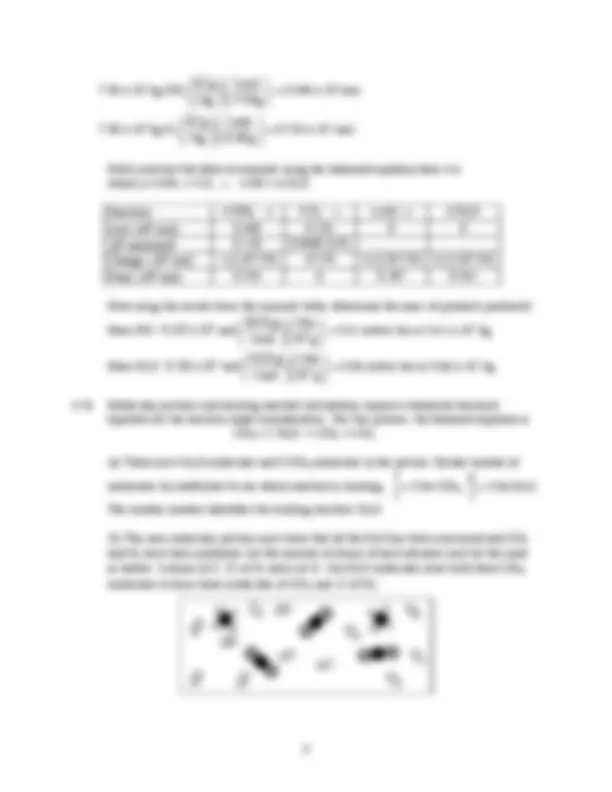
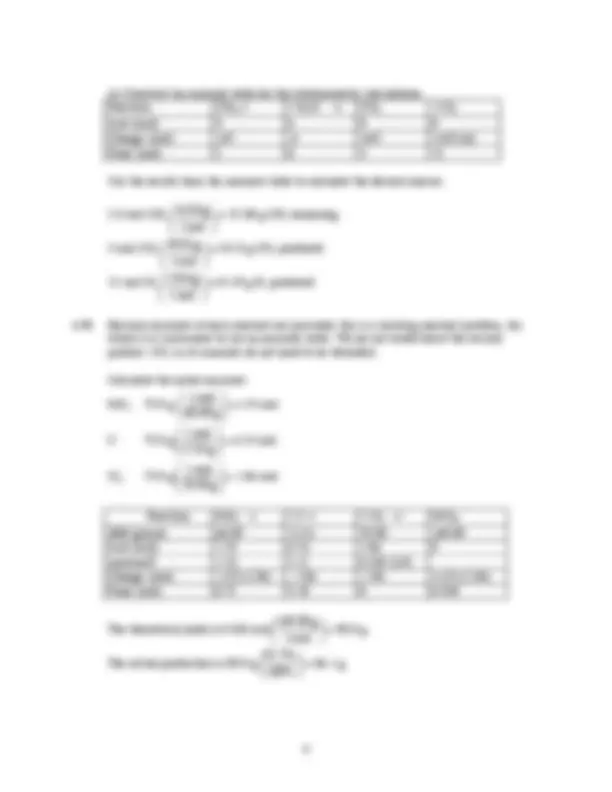
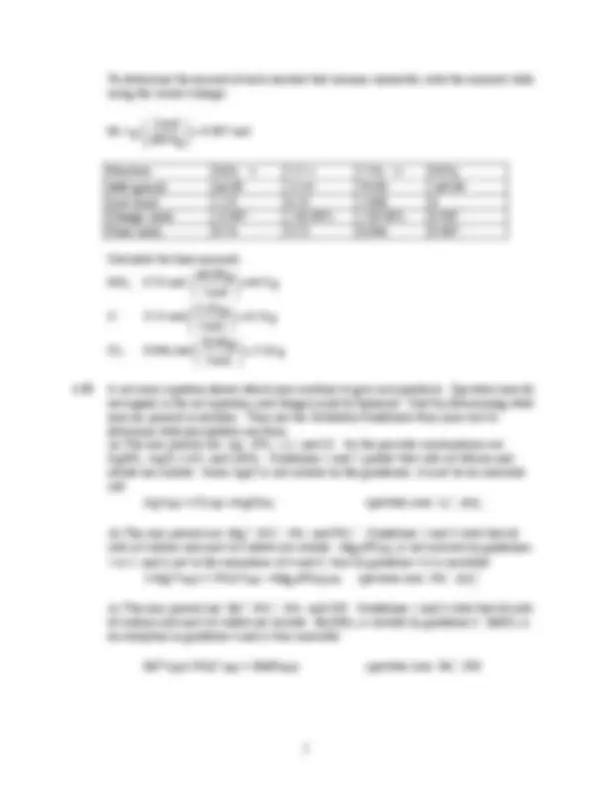
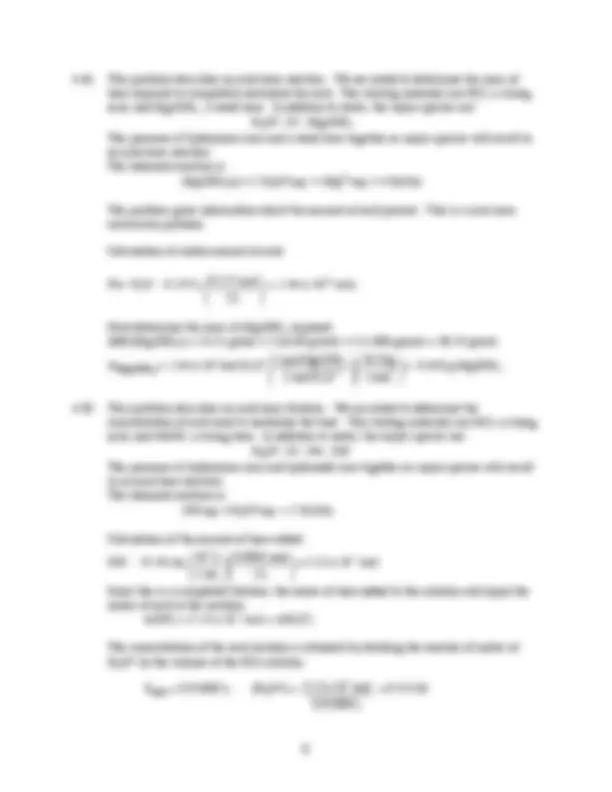
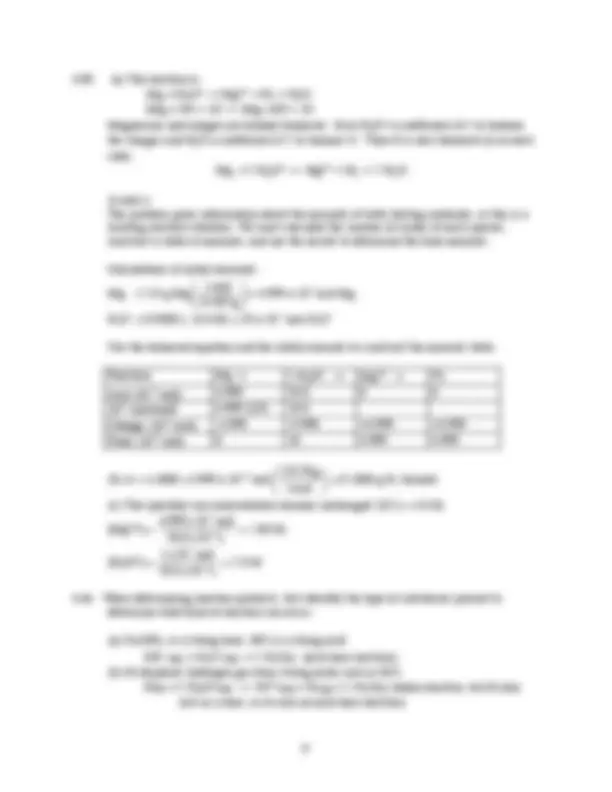
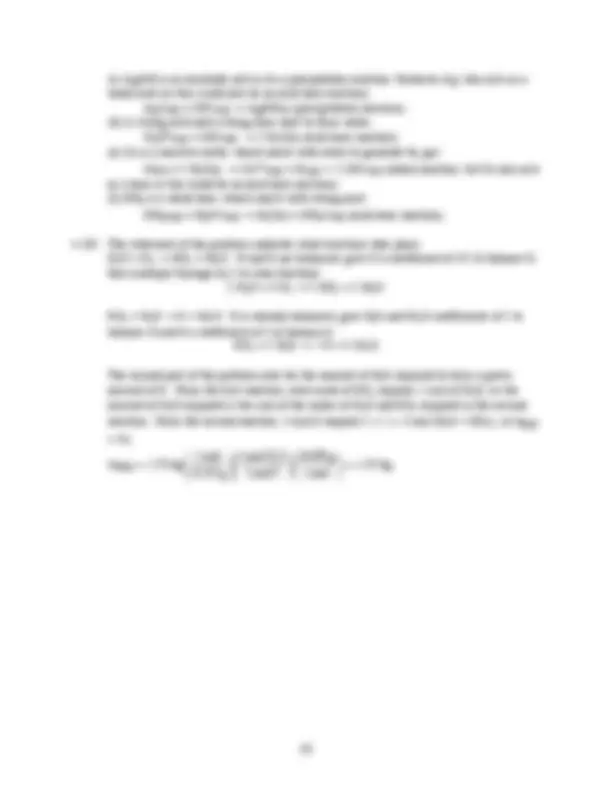


Study with the several resources on Docsity

Earn points by helping other students or get them with a premium plan


Prepare for your exams
Study with the several resources on Docsity

Earn points to download
Earn points by helping other students or get them with a premium plan
Community
Ask the community for help and clear up your study doubts
Discover the best universities in your country according to Docsity users
Free resources
Download our free guides on studying techniques, anxiety management strategies, and thesis advice from Docsity tutors
Material Type: Exam; Class: General Chemistry I; Subject: Chemistry; University: University of San Diego; Term: Unknown 1989;
Typology: Exams
1 / 10

This page cannot be seen from the preview
Don't miss anything!







Solutions 4a (Chapter 4 problems) Chem151 [Kua]
4.10 A balanced chemical equation must have equal numbers of atoms of each element on each
side of the arrow. Balance each element in turn, beginning with those that appear in only
one reactant and product, by adjusting stoichiometric coefficients. Generally, H and O are
balanced last. When balancing the equation, start by determining the number of atoms on
each side of the chemical equation.
(a) P
4
3
(b) Na
3
2
3
(c) 4 PH
3
2
4
10
2
(d) P
4
10
2
3
4
4.16 This problem tells you how much of the reactant you have (in kg) and asks you to
calculate the amount of product formed. Remember that calculations of amounts in
chemistry always center on the mole:
375 kg C
6
12
3
g
1 kg
1 mol
84.16 g
2 mol C
6
10
4
2 mol C
6
12
146.14 g
1 mol
1 kg
3
g
= 651 kg C
6
10
4
4.24 To calculate amounts required for a synthesis that is less than 100% efficient, first
convert the actual yield into a theoretical yield if 100% efficient and then do the usual
stoichiometric calculations. (Adipic acid = AA)
Theoretical yield (if 100% efficient) = 4.575kg
3.50 kg = !
Amt required: !
1 mol
84.16 g
2 mol AA
2 molC H
146.14 g
1 mol
4.575 kg AA
6 12
=2.63 kg C
6
12
4.78 The problem asks about amount of a product that forms from a given amount of reactant.
First balance the chemical equation. The reaction is:
8
18
2
2
2
Give CO
2
a coefficient of 8, and H
2
O a coefficient of 9 to balance C and H:
8
18
2
2
2
There are 25 O on the product side, so give O
2
a coefficient of 25/2 to balance O and
multiply through by 2 to eliminate the fraction:
8
18
2
2
2
Use the balanced equation to do the appropriate mass-mole-number calculations:
(a) n
CO
2
= 3.5 g
1 mol
114.2 g
16 mol CO
2
2 mol C
8
18
= 0.25 mol CO
2
(b) # = n N
A
= 0.25 mol
6.022 x 10
23
molecules
1 mol
= 1.5 x 10
23
molecules
(c) m = n MM = 0.25 mol
44.01 g
1 mol
= 11 g
4.28 The problem gives information about the amounts of both starting materials, so this is a
limiting reactant situation. We must calculate the number of moles of each species,
construct a table of amounts, and use the results to determine the mass of the product
formed.
Starting amounts are in kilograms, so it will be convenient to work with 10
3
mol amounts.
The balanced equation is given in the problem.
Calculate the initial amounts:
1.50 x 10
3
kg propene
4 2.08 g
1 mol
1 kg
10 g
3
= 35.6 x 10
3
mol;
6.80 x 10
2
kg NH
3
!
1 7.04 g
1 mol
1 kg
10 g
3
= 39.9 x 10
3
mol;
1.92 x 10
3
kg O
2
!
3 2.00 g
1 mol
1 kg
10 g
3
= 60.0 x 10
3
mol;
Next construct an amounts table:
Reaction 2 C
3
6
3
2
3
3
2
Amt (
3
mol) 35.6 39.9 60.0 0 0
kmol/coeff 17.8 (LR) 19.95 20.
Change (
3
mol) - 35.6 - 35.6 - (
2
3
Final (
3
mol) 0.0 4.3 6.6 35.6 106.
The mass of acrylonitrile that could be produced is:
35.6 x 10
3
mol
'
1 g
10 kg
1 mol
5 3.06 g
3
= 1.89 x 10
3
kg.
4.30 The problem gives information about the amounts of both starting materials, so this is a
limiting reactant situation. We must calculate the number of moles of each species,
construct a table of amounts, and use the results to determine the final masses of the
products.
Starting amounts are in 10
3
kilograms (
3
kg = 10
6
g), so it will be convenient to work
with 10
6
mol amounts. See the answers to problem 4.6 for the balanced equations.
(a) Begin by calculating the initial amounts:
(c) Construct an amounts table for the stoichiometric calculations:
Reaction CH
4
2
2
2
Amt (mol) 5 6 0 0
Change (mol) - 6/2 - 6 +6/2 +(4/2)(6)
Final (mol) 2 0 3 12
Use the results from the amounts table to calculate the desired masses:
2.0 mol CH
4
1 mol
16.04 g
= 32.08 g CH
4
remaining
3 mol CO
2
1 mol
44.01 g
=132.0 g CO
2
produced
12 mol H
2
1 mol
2.016 g
=24.19 g H
2
produced
4.98 Because amounts of each reactant are provided, this is a limiting reactant problem, for
which it is convenient to use an amounts table. We are not asked about the second
product, CO, so its amounts do not need to be tabulated.
Calculate the initial amounts:
SiO
2
: 75.0 g
60.09 g
1 mol
=1.25 mol
C: 75.0 g
12.01 g
1 mol
= 6.24 mol
Cl
2
: 75.0 g
70.90 g
1 mol
= 1.06 mol
Reaction SiO
2
2
→ SiCl
4
MM (g/mol) 60.09 12.01 70.90 169.
Amt (mol) 1.25 6.24 1.06 0
mol/coeff 1.25 3.12 0.530 (LR)
Change (mol) - (1/2)(1.06) - 1.06 - 1.06 +(1/2)(1.06)
Final (mol) 0.72 5.18 0 0.
The theoretical yield is 0.530 mol !
1 mol
169.89 g
= 90.0 g
The actual production is 90.0 g !
= 86.1 g.
To determine the amount of each reactant that remains unreacted, redo the amounts table
using the correct change:
86.1 g
169.9 g
1 mol
= 0.507 mol
Reaction SiO
2
2
→ SiCl
4
MM (g/mol) 60.09 12.01 70.90 169.
Amt (mol) 1.25 6.24 1.058 0
Change (mol) - 0.507 - 2(0.507) - 2(0.507) 0.
Final (mol) 0.74 5.23 0.046 0.
Calculate the final amounts:
SiO
2
: 0.74 mol !
1 mol
60.09 g
=44.5 g
C: 5.23 mol !
1 mol
12.01 g
= 62.8 g
Cl
2
: 0.046 mol !
1 mol
70.90 g
= 3.26 g
4.40 A net ionic equation shows which ions combine to give new products. Spectator ions do
not appear in the net equation, and charges must be balanced. Start by determining what
ions are present in solution. Then use the Solubility Guidelines from your text to
determine what precipitates can form.
(a) The ions present are: Ag
3
, Li
, and Cl
AgNO
3
, AgCl, LiCl, and LiNO
3
. Guidelines 1 and 2 predict that salts of lithium and
nitrate are soluble. Since AgCl is not soluble by the guidelines, it must be an insoluble
salt:
Ag
(aq) + Cl
(aq)→AgCl(s); spectator ions: Li
3
(b) The ions present are: Mg
2+
4
2 -
, Na
, and PO
4
3 -
. Guidelines 1 and 3 state that all
salts of sodium and most of sulfate are soluble. Mg
3
4
2
is not covered by guidelines
1 or 2, and is not in the exceptions of 4 and 5, thus by guideline 3 it is insoluble:
3 Mg
2+
(aq)+ 2 PO
4
3 -
(aq) →Mg
3
4
2
(s); spectator ions: Na
4
2!
(c) The ions present are: Ba
2+
4
2 -
, Na
, and OH
of sodium and most of sulfate are soluble. Ba(OH)
2
is soluble by guideline 5. BaSO
4
is
an exception in guideline 4 and is thus insoluble:
Ba
2+
(aq)+ SO
4
2 -
(aq)→ BaSO
4
(s); spectator ions: Na
(c) The second two parts of this problem involve stoichiometric calculations. The
problem gives information about the amounts of both starting materials, so this is a
limiting reactant situation. We must calculate the number of moles of each species,
construct a table of amounts, and use the results to determine the mass of product formed
and the final concentrations of all species.
Calculations of initial amounts:
Ca
2+
: n = 0.1000 L
1 .50 mol
= 0.150 mol
4
2 -
: n = 0.0750 L
3 .00 mol
= 0.225 mol
The balanced equation shows that the starting materials react in a 1:1 mole ratio, so we
can identify the limiting reactant by inspection; the limiting reactant is Ca
2+
. Here is the
complete table of amounts:
Reaction Ca
2+
4
2 -
CaSO
4
Start (mol) 0.150 0.225 0
Change (mol) - 0.150 - 0.150 +0.
Final (mol) 0 0.075 0.
Obtain the mass of precipitate from the final amount of CaSO 4
from the table:
MM = 40.08 g/mol + 32.07 g/mol + 4(16.00 g/mol) = 136.15 g/mol
The mass of precipitate is 0.150 mol
1 mol
1 36.15 g
= 20.4 g;
(d) To find ion concentrations in the final solution, first determine how many moles of
each ion remain in solution, then divide by the final volume of the solution, which is:
final
= 100.0 mL + 75.0 mL = 175.0 mL or 0.1750 L
The amounts of the two spectator ions are unaffected by the reaction:
4
4 2 4
4 2 4 4
1 mol(NH ) SO
2 mol NH
0.225mol(NH ) SO
3
'
3 2
3 2 3
1 molCa(NO )
2 mol NO
0.150molCa(NO )
The final moles of each reactant can be obtained from the amounts table in part c:
[Ca
2+
4
2 -
4.46 This problem describes an acid-base reaction. We are asked to determine the mass of
base required to completely neutralize the acid. The starting materials are HCl, a strong
acid, and Mg(OH)
2
, a weak base. In addition to water, the major species are:
3
, Cl
, Mg(OH)
2
The presence of hydronium ions and a weak base together as major species will result in
an acid-base reaction:
The balanced reaction is:
Mg(OH)
2
(s) + 2 H
3
(aq) → Mg
2+
(aq) + 4 H
2
O(l).
The problem gives information about the amount of acid present. This is a mol-mass
conversion problem:
Calculation of initial amount of acid:
For H
3
= 1.44 x 10
mol;
Now determine the mass of Mg(OH)
2
required:
MM [Mg(OH)
2
] = 24.31 g/mol + 2(16.00 g/mol) + 2(1.008 g/mol) = 58.33 g/mol
m
Mg(OH) 2
= 1.44 x 10
mol H
3
1 mol
5 8.33 g
2 molH O
1 mol Mg(OH)
3
2
= 0.420 g Mg(OH)
2
4.50 This problem describes an acid-base titration. We are asked to determine the
concentration of acid used to neutralize the base. The starting materials are HCl, a strong
acid, and NaOH, a strong base. In addition to water, the major species are:
3
, Cl
, Na
The presence of hydronium ions and hydroxide ions together as major species will result
in an acid-base reaction:
The balanced reaction is:
(aq) + H
3
(aq) → 2 H
2
O(l).
Calculation of the amount of base added:
: 32.45 mL
1 mL
= 3.13 x 10
mol
Since this is a completed titration, the moles of base added to the solution will equal the
moles of acid in the solution.
n (OH
) = 3.13 x 10
mol = n (H
3
The concentration of the acid solution is obtained by dividing the number of moles of
3
by the volume of the HCl solution.
soln
3
(c) AgOH is an insoluble salt so its a precipitation reaction. However Ag
also acts as a
weak acid (so this could also be an acid-base reaction).
Ag
(aq) + OH
(aq) → AgOH(s) (precipitation reaction);
(d) A strong acid and a strong base react to form water:
3
(aq) + OH
(aq) → 2 H
2
O(l) (acid-base reaction);
(e) Ca is a reactive metal, which reacts with water to generate H
2
gas:
Ca(s) + 2 H
2
O(l) → Ca
2+
(aq) + H
2
(g) + 2 OH
(aq) (redox reaction, but Ca also acts
as a base so this could be an acid-base reaction);
(f) NH
3
is a weak base, which reacts with strong acid:
3
(aq) + H
3
(aq) → H
2
O(l) + NH
4
(aq) (acid-base reaction).
4.102 The statement of the problem indicates what reactions take place:
2
2
2
2
O. H and S are balanced; give O a coefficient of 3/2 to balance O,
then multiply through by 2 to clear fractions:
2
2
2
2
2
2
2
O. H is already balanced; give H
2
S and H
2
O coefficients of 2 to
balance O and S a coefficient of 3 to balance S:
2
2
2
The second part of the problem asks for the amount of H
2
S required to form a given
amount of S. From the first reaction, each mole of SO
2
requires 1 mol of H
2
S, so the
amount of H
2
S required is the sum of the moles of H
2
S and SO
2
required in the second
reaction. From the second reaction, 3 mol S requires 2 + 1 = 3 mol (H
2
2
), so n
H
2
S
= n
S
m
H 2
S
= 1.25 kg !
1 mol
34.09 g
1 mol S
1 molH S
32.07 g
1 mol
2
= 1.33 kg.